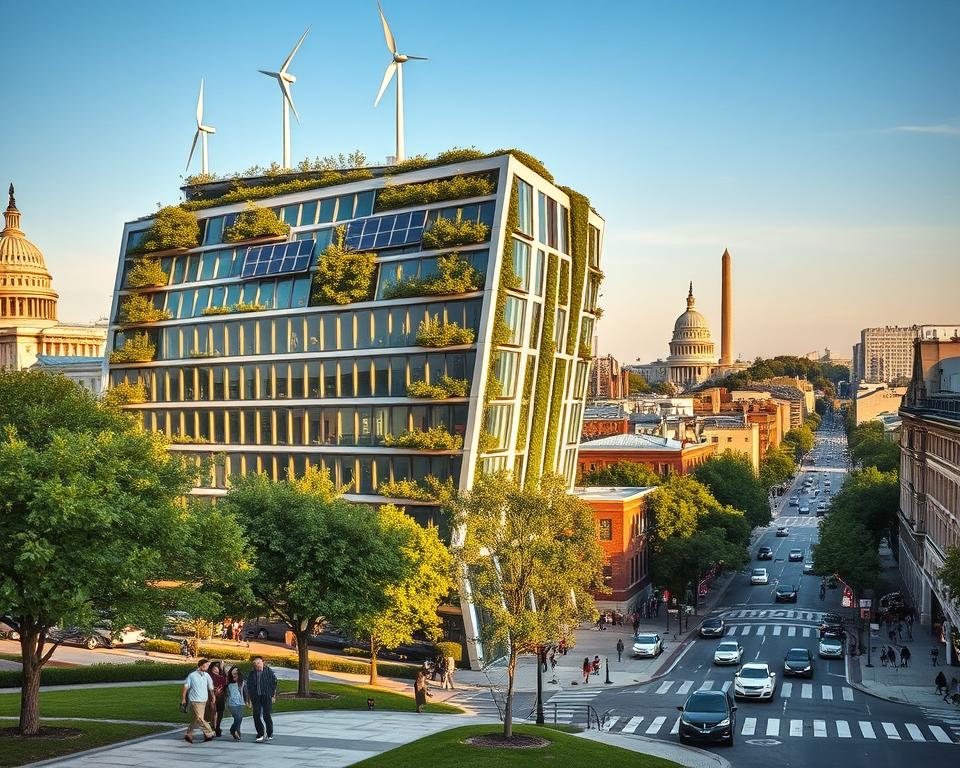Earth Bound Building: Straw bale Homebuilding in Montgomery
Did you know how homes made using eco-friendly building materials may cut energy costs as much as 50%? That’s one big reason why increasing numbers of homeowners prefer sustainable architecture. Earth Bound Building, serving Montgomery, is at the forefront of this movement, specializing in forward-thinking and high-efficiency projects.
By using bio-based materials such as straw bales in timber frames, Earth Bound Building delivers sustainable farm building Montgomery that remain both planet-conscious and remarkably durable. Their approach combines traditional craftsmanship with contemporary green practices, ensuring every project achieves the top standards of sustainability.
What sets Earth Bound Building apart is their craftsman-led process and meaningful community involvement. They partner with homeowners to craft spaces that match their values and needs. For those seeking a greener way to build, Earth Bound Building is your go-to partner in Montgomery.
Understanding Strawbale Construction?
Straw, sometimes treated as waste, is transforming eco-design. Building with straw bales involves stacking bales in timber frames to form walls that are both insulating and structural. The approach uses an agricultural byproduct, making it a renewable and earth-friendly choice.
Straw is produced from grain crops such as wheat, rice, or barley. In place of burning or discarding it, farmers can supply it for construction. That cuts agricultural waste and supplies a sustainable material for homes. The method is straightforward, well-suited to owner-builders and community projects.
One of the distinctive features of straw bale walls is their insulation performance. Compared to traditional materials like fiberglass or wood, straw bales have a higher R-value. In practice, this means they hold heat better, leading to decreased energy costs. Here’s a quick comparison:

| Material | Thermal R-Value/inch |
|---|---|
| Strawbale | R-2.38 |
| Fiberglass | R-2.20 |
| Wood | R-1.41 |
Another plus is the use of chemical-free materials. Straw bales are without harmful chemicals, encouraging healthier indoor air quality. This makes them a safe choice for families and green-minded homeowners.
In summary, straw bale construction is a low-impact, energy-efficient, and health-conscious option. It’s a strong choice for those aiming to reduce their environmental footprint while gaining long-term savings.
Why Partner with Earth Bound Building for Your Project?
Choosing the right team for your sustainable project is crucial. Earth Bound Building is a leader in eco-friendly design, offering modern solutions customized for your needs. Their approach blends leading techniques with a genuine respect for the environment.
Commitment to Sustainability
Earth Bound Building prioritizes sustainable practices in every project. They use carbon-storing straw and low-carbon materials to lower environmental impact. This not only benefits the planet but also supports long-term savings for homeowners.
Their collaborations with regional farmers ensure ethically sourced materials. By backing local agriculture, they contribute to a circular economy. This commitment to sustainability differentiates them in the industry.
Local Expertise in Montgomery
With strong connections in Montgomery, Earth Bound Building knows the unique needs of the area. They are well-versed in local climate conditions, permitting processes, and supply chains. This expertise ensures smooth project execution and compliance with regulations.
Their site-specific designs reflect Montgomery’s aesthetic preferences while complying with strict building codes. Whether it’s a residential or commercial project, they create results that fit into the local environment.
| Focus | Earth Bound Building | Typical Approaches |
|---|---|---|
| Sourcing of Materials | Local, ethically sourced straw | Imported, high-embodied energy materials |
| Thermal Performance | High R-value insulation | Standard insulation |
| Carbon Footprint | Low carbon footprint | Higher emissions |
Earth Bound Building’s commitment to sustainability and local expertise makes them the ideal choice for your next project. Their progressive practices and locally engaged approach provide a seamless and eco-friendly experience.
The Advantages of Straw-bale Building Montgomery
Green building is growing rapidly for its ability to unite innovation with environmental responsibility. One of the most promising methods in this field is the use of straw bales. This approach delivers a range of benefits, from energy efficiency to eco-friendliness, making it an appealing option for modern homeowners.
Energy Efficiency and Cost Savings
Straw bale walls provide outstanding insulation, surpassing traditional materials such as fiberglass. With an R-value of 2.38 per inch, they help stabilize indoor temperatures, reducing the need for heating and cooling. This can result in energy savings of 50%–75%.
Over time, these savings offset the initial construction costs. Homeowners gain lower energy bills while supporting a greener planet. Here’s how straw bales measure up to other materials:
| Material | R-Value (per inch) |
|---|---|
| Strawbale | R-2.38 |
| Fiberglass | R-2.20 |
| Wood | R-1.41 |
Eco-Friendly and Renewable
Straw is a renewable resource that is harvested every year, whereas timber, which takes decades to mature. Using straw in construction reduces agricultural waste and promotes a circular economy. It also traps CO₂ in the walls, helping combat climate change.
Additionally, straw bale walls are free of toxic additives, improving indoor air quality. They are also fire-resistant, with plastered walls surpassing 2-hour fire ratings. This makes them a dependable and eco-friendly choice for any project.
By choosing straw bale construction, you’re building more than a house—you’re committing to a more wholesome, more sustainable future.
How Straw-bale Homes Are Constructed
There are a few ways to build sustainable homes using straw bales. Each method delivers unique benefits, from structural support to streamlined installation. Knowing these options can help you select the best approach for your project.
Nebraska Style vs. In-Fill Wall Systems
The Nebraska Style is a historical method where bale walls serve as the primary structural support. This approach is well-suited for smaller homes and prioritizes simplicity. The bales are stacked directly on the foundation, reducing the need for the need for additional posts or frames.
In contrast, In-Fill Wall Systems use timber frames to handle the structural load. The bales are installed within these frames, enabling faster roof installation and broader design flexibility. This method is preferred for larger projects where customization is key.
Prefabricated Straw Wall Panels
Prefabricated panels are a contemporary innovation in straw bale construction. These factory-built panel sections minimize on-site man-hours and limit weather-related risks. They are designed for quick assembly, which makes them a practical choice for time-sensitive projects.
Below is a comparison of the three methods:
| Method | Highlights | Best For |
|---|---|---|
| Nebraska Style | Load-bearing bales, simple build | Small homes |
| In-Fill Systems | Timber frames, design flexibility | Larger projects |
| Prefabricated Panels | Factory-built, reduced on-site work | Quick installations |
Each method has its strengths, and the choice depends on your project’s needs. Whether you choose traditional techniques or modern innovations, straw bale construction delivers a sustainable and effective solution.
Common Myths About Straw-bale Construction
Many people hold myths around sustainable materials like straw. These myths often prevent homeowners from exploring eco-friendly options. Let’s clear up some of the most common concerns.
Fire Resistance and Safety
One of the biggest myths is that straw is a fire hazard. In reality, compressed bales do not have the oxygen needed to burn. Lab tests show that plastered straw walls can withstand 2+ hours of fire exposure. This outperforms the fire resistance of many traditional materials like lumber.
Plaster acts as a protective barrier, enveloping the bales and preventing ignition. This renders straw-based structures safer than many people assume. Below is a quick comparison:
| Material | Fire Rating |
|---|---|
| Straw (plastered) | 2+ hours |
| Wood | 1 hour |
Pest and Moisture Management
Another concern is pests. Straw has little to no nutritional value, making it unattractive to rodents and insects. When sealed with plaster, it becomes extremely difficult for pests to penetrate. This neutralizes one of the most common worries homeowners worry about.
Moisture is also manageable with proper design. Elevated foundations, wide eaves, and permeable finishes like vapor-permeable stucco help prevent rot. Modern techniques help ensure these homes remain durable for decades.
Compare how straw performs versus traditional materials in moisture control:
| Material | Moisture Control |
|---|---|
| Straw with Proper Design | High |
| Wood without Treatment | Low |
By dispelling these myths, it’s clear that straw-based structures are a sound, sustainable, and long-lasting choice for modern homes.
Is a Straw bale Home Right for You?
Designing a home that’s both appealing and green is easier than you think. With unique features such as deep window niches and rounded designs, eco-friendly homes deliver endless possibilities. Consider why this is the perfect choice for you.
Customization and Aesthetic Appeal
One of the defining features of these homes is their design flexibility. You can create organic walls, arched doorways, and built-in shelving to match your style. The thick walls also deliver great acoustic privacy, making your space peaceful and quiet.
Rustic plaster finishes add a unique charm, merging modern aesthetics with natural elements. Whether you’re an artist or an eco-conscious family, these homes can be tailored to mirror your personality and needs.
Long-Term Benefits and Sustainability
Choosing a sustainable home isn’t just about the environment—it’s also a savvy financial decision. These homes have lower upkeep over time, thanks to their energy efficiency. With decreased heating and cooling bills, you’ll see meaningful savings on utilities.
Additionally, green homes can receive tax incentives and have higher property values. Below is a quick comparison of lifecycle costs:
| Cost Area | Straw Bale Homes | Conventional Homes |
|---|---|---|
| Utilities | Lower | Higher |
| Upkeep | Minimal | Regular |
| Resale Value | Higher | Standard |
Earth Bound Building’s planning process makes sure your goals match your budget. Whether you’re planning an off-grid retreat or a family home, they’ll support you every step of the way.
The Final Word
Adopting eco-friendly living is powered by the right materials and the right team. Straw bale homes offer unmatched benefits, from energy efficiency to durability. They reduce costs while benefiting the environment, making them a smart choice for modern homeowners.
Earth Bound Building leads the way in eco-friendly construction in Montgomery. Their expertise delivers every project achieves the highest standards of quality and sustainability. Become part of the growing community of homeowners who’ve chosen this modern approach.
Eager to begin? Reach out to Earth Bound Building for a custom consultation. Join their workshops or visit completed projects to see the benefits firsthand. Building with bale not only builds a residence but also strengthens regenerative agriculture and local economies.

